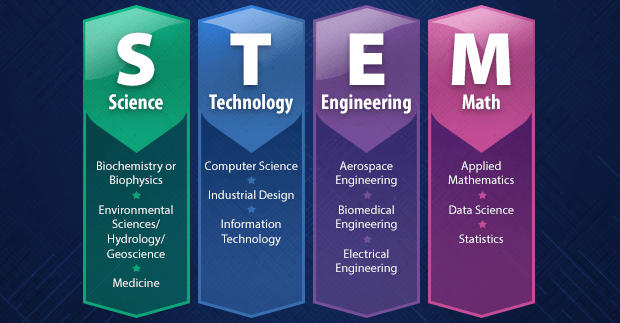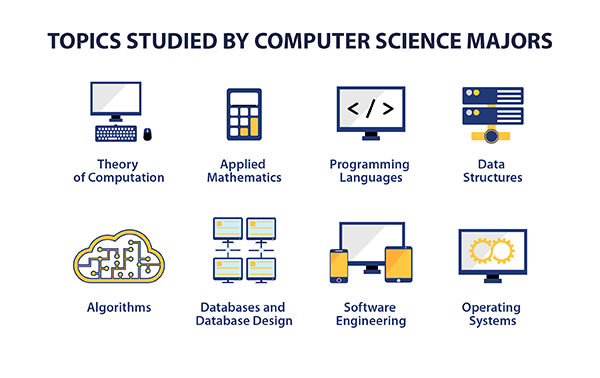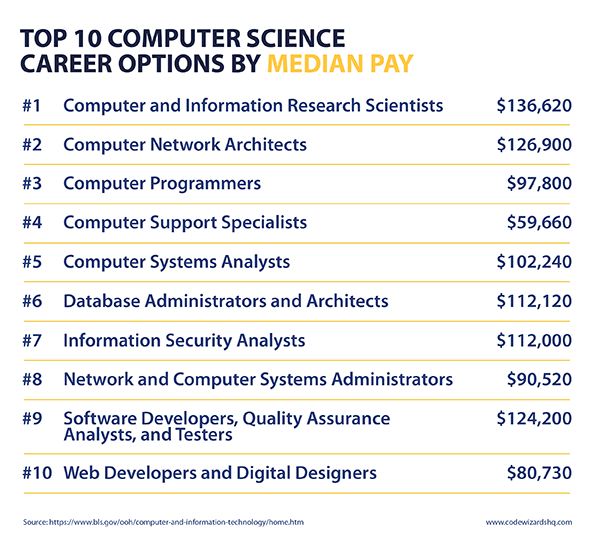STEM (Science Technology Engineering and Mathematics) covers various fields of study with computer science being one of the most popular topics.
STEM majors have become increasingly sought-after over the years because of the lucrative and diverse areas of study and opportunities they offer.
If you’re not sure how computer science fits into STEM, I’ll define STEM and computer science, clarify how they are linked, and discuss the important role CS plays in STEM education.
What is STEM?
STEM stands for Science, Engineering, Technology, and Mathematics. STEM education is an approach to education that focuses on the hard sciences, develops critical thinking skills, and improves problem-solving abilities.

Educating students in STEM topics is about preparing kids for a digital future and understanding the new world around them.
The primary goal of STEM education is to integrate those four subjects so students develop 21st-century skills. The interdisciplinary nature of STEM promotes critical thinking, problem-solving, and innovation.
“If we want a nation where our future leaders, neighbors, and workers can understand and solve some of the complex challenges of today and tomorrow, and to meet the demands of the dynamic and evolving workforce, building students’ skills, content knowledge, and literacy in STEM fields is essential.” US Dept of Education
Recommended: The Ultimate List of STEM Statistics
What is computer science?
Computer science (CS) is the study of computers and computational systems including:
- the theory, design, development, and application of software and software systems
- algorithmic processes
- the application of computer technology to science, business, and the arts
- using computational techniques to solve problems
Coding also plays a large role in computer science. Coding and programming are the applied portions of computer science. Beyond learning to code; CS encompasses a wide range of topics, including artificial intelligence, machine learning, software engineering, and more.
Computer scientists are strong in skills like problem-solving, computational thinking, and decision-making.
Key disciples within Computer Science include:
Algorithms and Data Structures: The study of algorithms, which are step-by-step procedures or formulas for solving problems, and data structures, which are ways of organizing and storing data.
Programming: Writing code to create software applications, websites, games, and other computer programs using programming languages like Python, Java, C++, and others.
Artificial Intelligence (AI) and Machine Learning (ML): Developing systems that can perform tasks that normally require human intelligence, such as speech recognition, image recognition, decision-making, and problem-solving.
Computer Networks: Understanding how computers communicate with each other over networks, including the internet. This includes the study of protocols, data transmission, and network security.
Software Engineering: The systematic design, development, testing, and maintenance of software. This involves applying engineering principles to software development processes.
Database Systems: Designing and managing databases, which are organized collections of data. This includes database modeling, querying, and ensuring data integrity.
Human-Computer Interaction (HCI): Studying the interaction between humans and computers, with a focus on designing user-friendly interfaces and experiences.
Cybersecurity: Protecting computer systems, networks, and data from security breaches and unauthorized access.
How are STEM and computer science related to one another?
STEM and computer science are inextricably linked because computer science applies across every STEM discipline.
Computer science is a part of the technology category but also has features of science, engineering, and math. Each of those fields utilizes programming and pulls theory and practice from computer science in order to solve problems.
All disciplines rely on computer technology and innovations developed through computer science.
Science
It’s in the name! While there is some debate, I’d argue that computer science meets the qualifications for being a science.
Computer scientists study information processes, which occur naturally in the physical world; and computer scientists work with an accepted, systematized body of knowledge; much computer science is applied; and computer science is used for prediction and verification.
Technology
Computer science is strongly in the technology field because computers help us apply scientific knowledge to improve our lives. Basic technology and computer skills have become essential for most parts of daily life including education, work, and personal pursuits.
Computer scientists and programmers are often at the forefront of technological innovation. As technology becomes more pervasive, educators acknowledge that Computer Science is a crucial component of a comprehensive STEM education.
Engineering
Engineering is the designing, testing, and building of machines, structures, and processes using math and science. Engineers use natural science, mathematics, and the engineering design process to solve technical problems.
In computing, there is no clear division between science and engineering. However, there are majors that separate computer science (eg. data structures and algorithms) and computer engineering (eg. hardware architecture).
Mathematics
Math is the foundation of computer science. The theoretical foundation of CS heavily relies on mathematical concepts such as logic, discrete mathematics, and algorithms. Understanding these mathematical principles is essential for writing efficient code, algorithms, and solving complex computational problems.
More difficult problems in computer science often involve a higher level of math knowledge. For example, fields like artificial intelligence and machine learning require a thorough knowledge of mathematical concepts like linear algebra, multivariable calculus, probability theory, etc.
More than anything, STEM education emphasizes critical thinking and problem-solving skills. So, computer science is a natural fit for these objectives. Programming requires a logical and systematic approach to problem-solving and also involves analytical thinking.
Recommended: Computer Science Classes for Kids
Is computer science a STEM major?
Yes, computer science is a popular STEM major.
Computer science is a STEM major at most colleges. STEM majors, besides being included in one of the four disciplines, also emphasize research, innovation, and the development of new technologies.
Computer science majors will find that they often have to take classes in science, engineering, and mathematics as part of their studies.
Depending on the university, computer science may be considered a Bachelor of Science or a Bachelor of Arts degree. In some schools, it may also be a part of the College of Engineering.
Computer science goes beyond just coding; it encompasses a range of topics, including artificial intelligence, machine learning, software engineering, and more. A computer science degree is versatile, providing a solid foundation in problem-solving, critical thinking, and technical skills that can be applied across various industries, from software development and cybersecurity to data analysis and artificial intelligence.
As technology becomes a bigger part of industries, the role of CS in STEM education becomes more important.
Topics Studied For a Computer Science Degree
Most students will encounter these areas of study in their computer science education. You may also be required to take relevant math and science courses.
However, specific topics will differ from school to school and the focus may change depending on program and degree type.
A computer science degree is versatile because the topics and skills learned are applicable to various fields and are highly valued in today’s workforce.

Computer Science Major Topics
Theory of Computation
The theory of computation is the branch that deals with what problems can be solved on a model of computation, using an algorithm, how efficiently they can be solved, or to what degree. This is one of the first things CS majors will learn.
Applied Mathematics
Applied mathematics involves the application of mathematics to problems that arise in various areas, e.g., science, engineering, or other diverse areas, and/or the development of new or improved methods to meet the challenges of new problems. Most degree programs require a basic understanding of calculus, algebra, discrete mathematics, and statistics.
Programming Languages
Programming languages may differ from program to program but can include languages like Java, C++, Python, Assembly and C, and more. You will likely be exposed to many programming languages and systems by the time you graduate.
Data Structures
A data structure is a data organization, management, and storage format that is usually chosen for efficient access to data. Data structures make it easy for users to access and work with the data they need in appropriate ways.
Algorithms
Algorithms are processes or sets of rules followed in calculations or other problem-solving operations, especially by a computer. It’s a fundamental concept in computer science and most programs cover algorithms extensively.
Databases and Database Design
Database design is the organization of data according to a database model. The design is a crucial step in the software development life cycle.
Software Engineering
Software engineering is the branch of computer science that deals with the design, development, testing, and maintenance of software applications. These engineers apply engineering principles and knowledge of programming languages to build software solutions for end users.
Operating Systems
An operating system (OS) is system software that manages computer hardware and software resources and provides common services for computer programs.
Recommended: Python Classes for Kids
Career Options for Computer Science Majors
A computer science degree opens up many diverse career opportunities for students. Jobs in computer and information technology are growing quickly, but there are also opportunities in other leading industries like healthcare, finance, and manufacturing. Computer-related jobs are highly sought after in any computer-intensive business.
According to Code.org, “67% of all new jobs in STEM are in computing.”
So, there is no shortage of jobs for computer science majors in and outside of the CS field.
Career Options in Computer Science
Top 10 computer science career options by median pay:
- Computer and Information Research Scientists $136,620
- Computer Network Architects $126,900
- Computer Programmers $97,800
- Computer Support Specialists $59,660
- Computer Systems Analysts $102,240
- Database Administrators and Architects $112,120
- Information Security Analysts $112,000
- Network and Computer Systems Administrators $90,520
- Software Developers, Quality Assurance Analysts, and Testers $124,200
- Web Developers and Digital Designers $80,730
Source: https://www.bls.gov/ooh/computer-and-information-technology/home.htm

According to the Bureau of Labor Statistics, “the median annual wage for computer and information technology occupations was $100,530 in May 2022, which was higher than the median annual wage for all occupations of $46,310.”
Jobs for computer science grads are growing too.
“Overall employment in computer and information technology occupations is projected to grow much faster than the average for all occupations from 2022 to 2032.”
Other computer science career opportunities in STEM and beyond:
- Artificial intelligence
- Cybersecurity
- Bioinformatics
- Business analyst
- Data scientist
- Product manager
- Research and development (R&D) scientist
- Financial data analyst
- IT
These are just a few examples of possible career paths and there will likely be many new opportunities in the future.
Learn Computer Science in High School
STEM and computer science are great options for students who want to be well-prepared for the future. High school students can start their computer science education with CodeWizardsHQ.
The high school coding program offers engaging, live coding classes that teach the programming topics and skills learned in computer science. There are also Java coding classes in the summer to prepare students for AP computer science classes in junior and senior year.
Teens will learn to code in popular languages like Python and JavaScript and have the opportunity for a real-world internship. Most importantly, they’ll gain the skills and knowledge of a STEM-focused education.
It’s pretty clear that computer science is an important part of STEM education. Both play a critical role in our society and have implications for generations to come.
